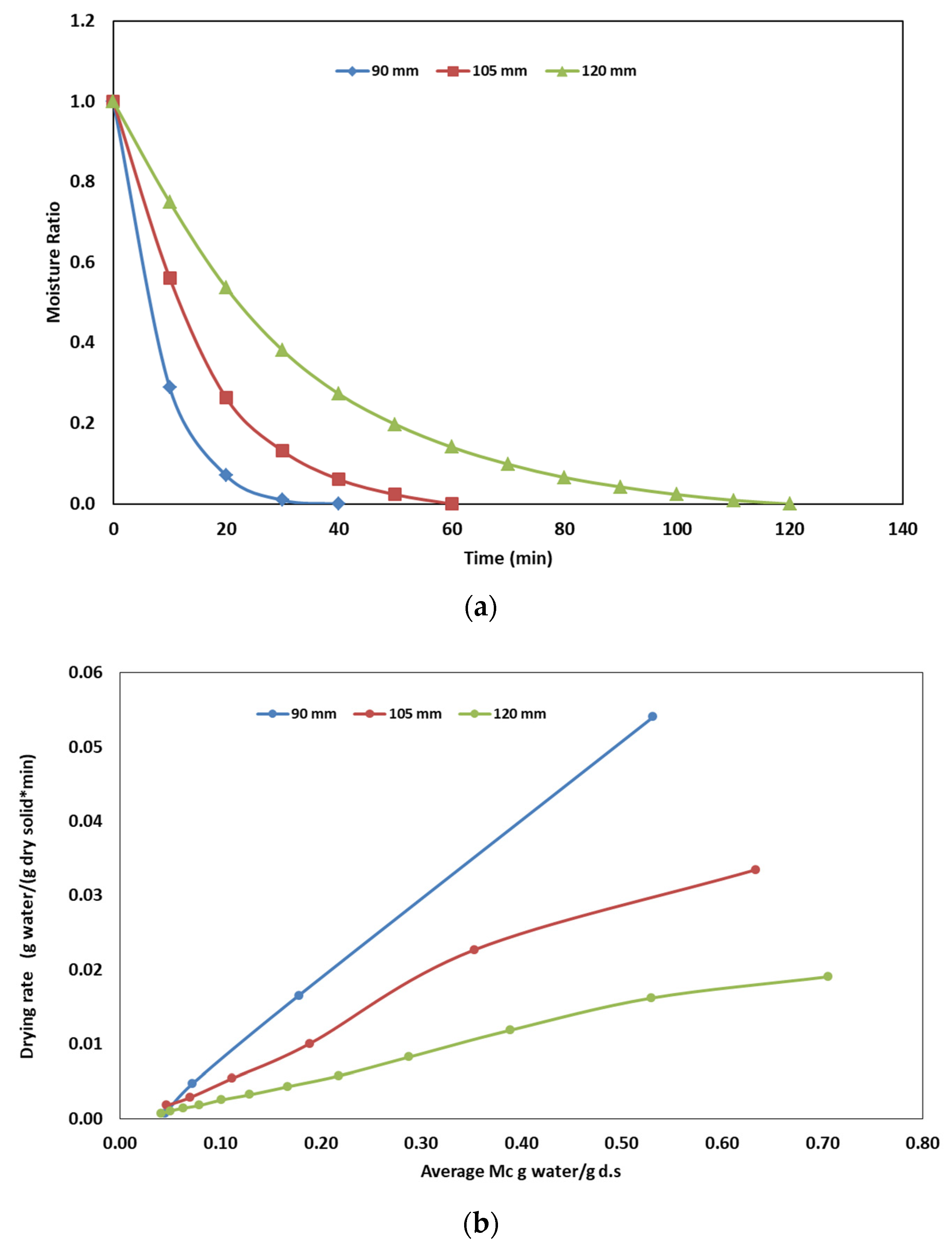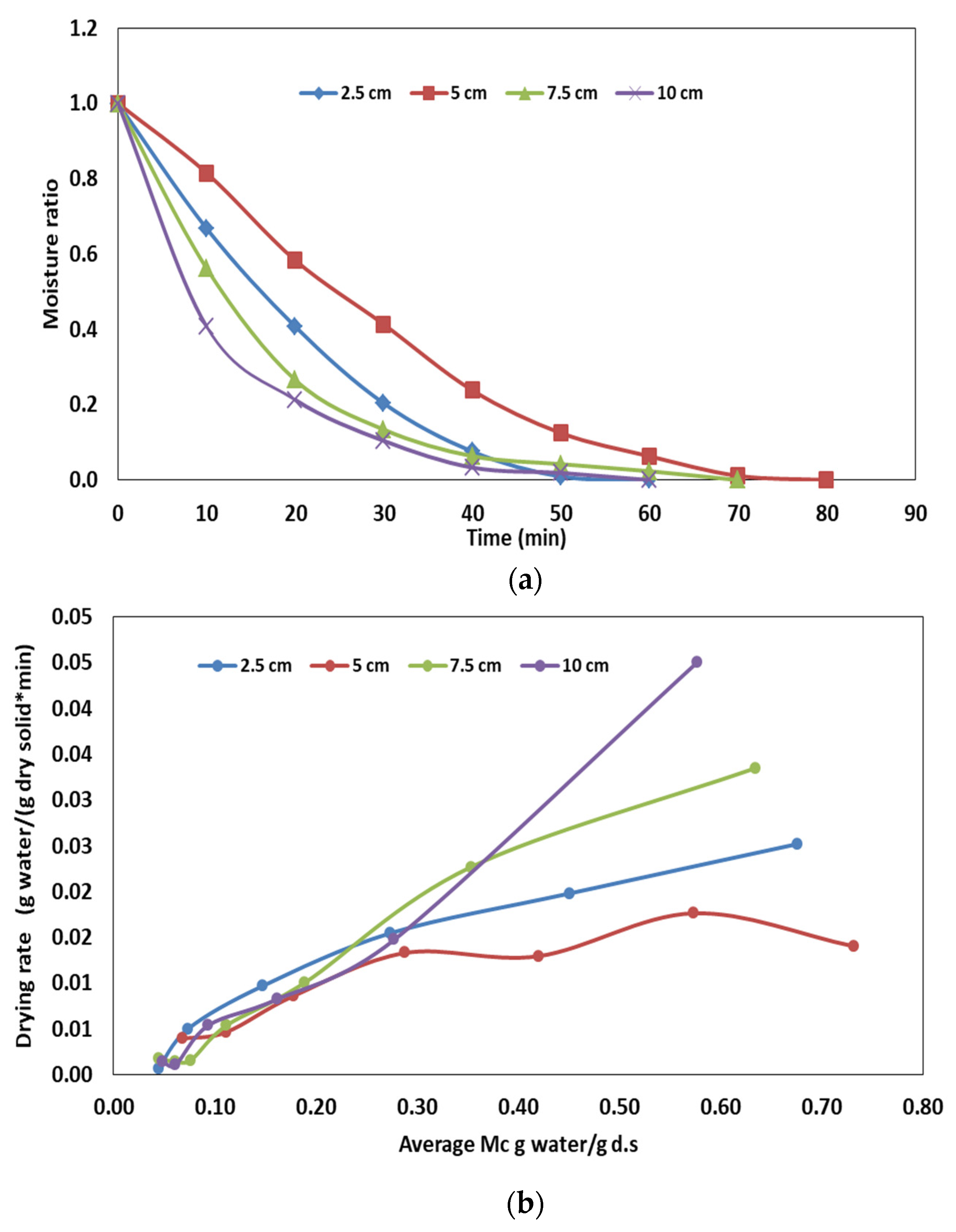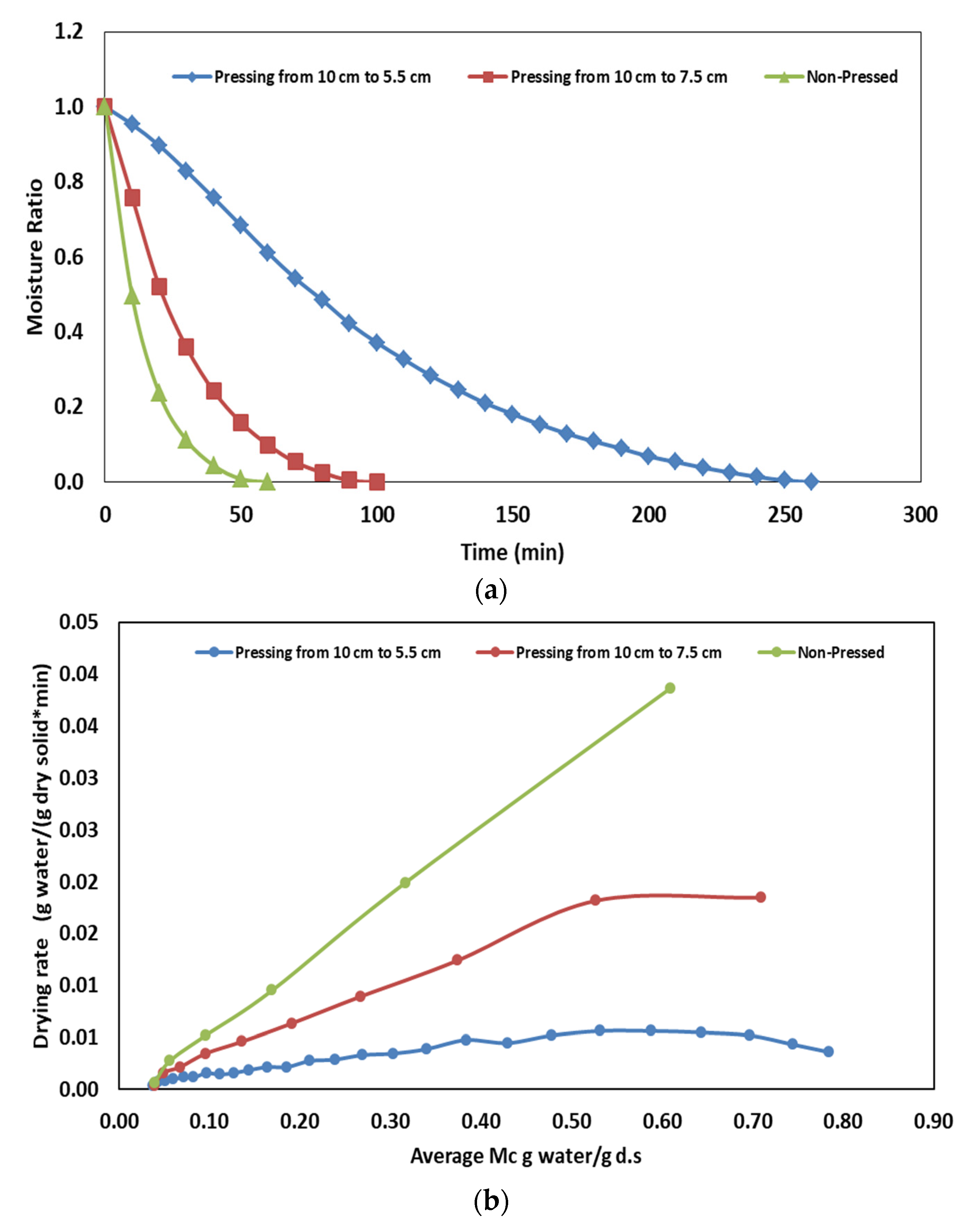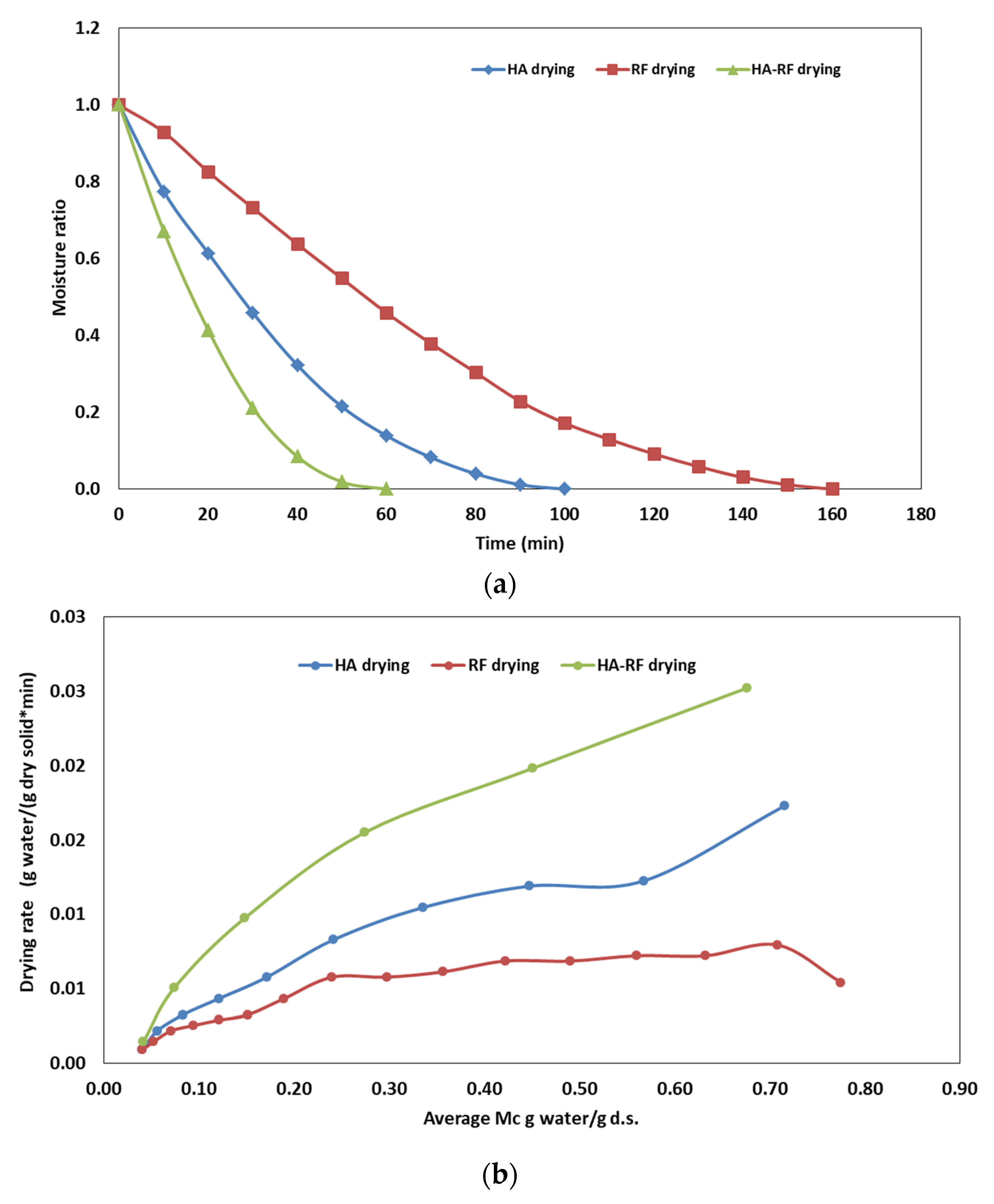Hot-Air-Assisted Radiofrequency Drying of Olive Pomace and Its Effect on the Quality of Olive Pomace Oil
Abstract
:1. Introduction
2. Materials and Methods
2.1. Materials
2.2. Hot-Air-Assisted Radiofrequency Drying
2.3. Drying Behavior
2.4. Moisture Content and Oil Content Determination
2.5. Oil Quality Evaluation
2.6. Color Measurement
2.7. Determination of Fatty Acid Composition
2.8. Determination of the Chlorophyll and Total Carotenoid Contents
2.9. Determination of Benzo(a)pyrene
3. Results and Discussion
3.1. Effect of Electrode Gap, Sample Thickness and Compaction Density on Drying Behavior of Olive Pomace
3.2. Comparison of HA–RF, HA and RF Drying
3.3. Physical and Chemical Properties of Crude Olive Pomace Oil
4. Conclusions
Author Contributions
Funding
Data Availability Statement
Conflicts of Interest
References
- Alkhatib, A.; Tsang, C.; Tuomilehto, J. Olive oil nutraceuticals in the prevention and management of diabetes: From molecules to lifestyle. Int. J. Mol. Sci. 2018, 19, 2024. [Google Scholar] [CrossRef] [PubMed]
- Petrakis, C. Olive oil extraction. In Olive Oil; Elsevier: Amsterdam, The Netherlands, 2006; pp. 191–223. [Google Scholar]
- Ncube, A.; Fiorentino, G.; Panfilo, C.; De Falco, M.; Ulgiati, S. Circular economy paths in the olive oil industry: A Life Cycle Assessment look into environmental performance and benefits. Int. J. Life Cycle Assess. 2022, 1–21. [Google Scholar] [CrossRef]
- Ergönül, P.G.; Sánchez, S. Evaluation of polycyclic aromatic hydrocarbons content in different types of olive and olive pomace oils produced in Turkey and Spain. Eur. J. Lipid Sci. Technol. 2013, 115, 1078–1084. [Google Scholar] [CrossRef]
- Göker, G.; Kıralan, S.; Tekin, A.; Erdoğdu, F. Formation kinetics of polycyclic aromatic hydrocarbons (PAHs) during drying process of olive pomace. Food Chem. 2021, 345, 128856. [Google Scholar] [CrossRef] [PubMed]
- Yanık, D.K. Alternative to traditional olive pomace oil extraction systems: Microwave-assisted solvent extraction of oil from wet olive pomace. LWT-Food Sci. Technol. 2017, 77, 45–51. [Google Scholar] [CrossRef]
- Kiralan, S.S.; Erdogdu, F.; Tekin, A. Reducing polycyclic aromatic hydrocarbons (PAHs) formation in olive pomace oil using microwave pre-heating of olive pomace. Eur. J. Lipid Sci. Technol. 2017, 119, 1600241. [Google Scholar] [CrossRef]
- Cosme-De Vera, F.H.; Soriano, A.N.; Dugos, N.P.; Rubi, R.V.C. A comprehensive review on the drying kinetics of common tubers. Appl. Sci. Eng. Prog. 2021, 14, 146–155. [Google Scholar] [CrossRef]
- Duangchuen, J.; Pathaveerat, S.; Noypitak, S.; Jermwongruttanachai, P. Effect of spray drying air temperature to the changes of properties of skimmed coconut milk powder. Appl. Sci. Eng. Prog. 2021, 14, 187–195. [Google Scholar] [CrossRef]
- Jitwiriya, W.; Chantrasmi, T.; Nontakaew, U.; Yongyingsakthavorn, P. Heat loss analysis of continuous drying oven with outside conveyor chain. Appl. Sci. Eng. Prog. 2021, 14, 387–396. [Google Scholar] [CrossRef]
- Koukouch, A.; Idlimam, A.; Asbik, M.; Sarh, B.; Izrar, B.; Bostyn, S.; Bah, A.; Ansari, O.; Zegaoui, O.; Amine, A. Experimental determination of the effective moisture diffusivity and activation energy during convective solar drying of olive pomace waste. Renew. Energy 2017, 101, 565–574. [Google Scholar] [CrossRef]
- Meziane, S. Drying kinetics of olive pomace in a fluidized bed dryer. Energy Convers. Manag. 2011, 52, 1644–1649. [Google Scholar] [CrossRef]
- Montero, I.; Miranda, T.; Arranz, J.I.; Rojas, C.V. Thin layer drying kinetics of by-products from olive oil processing. Int. J. Mol. Sci. 2011, 12, 7885–7897. [Google Scholar] [CrossRef] [PubMed]
- Baysan, U.; Koç, M.; Güngör, A.; Ertekin, F.K. Investigation of drying conditions to valorize 2-phase olive pomace in further processing. Dry. Technol. 2022, 40, 65–76. [Google Scholar] [CrossRef]
- Gomes, T.; Caponio, F. Evaluation of the state of oxidation of crude olive-pomace oils. Influence of olive-pomace drying and oil extraction with solvent. J. Agric. Food Chem. 1997, 45, 1381–1384. [Google Scholar] [CrossRef]
- Wang, C.; Kou, X.; Zhou, X.; Li, R.; Wang, S. Effects of layer arrangement on heating uniformity and product quality after hot air assisted radio frequency drying of carrot. Innov. Food Sci. Emerg. Technol. 2021, 69, 102667. [Google Scholar] [CrossRef]
- Elik, A. Hot air-assisted radio frequency drying of black carrot pomace: Kinetics and product quality. Innov. Food Sci. Emerg. Technol. 2021, 73, 102800. [Google Scholar] [CrossRef]
- Özbek, H.N.; Koç, B.; Koçak Yanık, D.; Göğüş, F. Hot air-assisted radiofrequency drying of avocado: Drying behavior and the associated effect on the characteristics of avocado powder. J. Food Process Eng. 2022, 45, e14094. [Google Scholar] [CrossRef]
- Özbek, H.N. Radio frequency-assisted hot air drying of carrots for the production of carrot powder: Kinetics and product quality. LWT-Food Sci. Technol. 2021, 152, 112332. [Google Scholar] [CrossRef]
- Kemal, E.; Özbek, H.N.; Göğüş, F.; Yanık, D.K. Hot air-assisted radio frequency drying of grated potato (Solanum tuberosum L.): Drying behavior and the associated effect on characteristics of potato flour. J. Food Sci. 2022, 87, 4068–4081. [Google Scholar] [CrossRef]
- Zhang, H.; Gong, C.; Wang, X.; Liao, M.; Yue, J.; Jiao, S. Application of hot air-assisted radio frequency as second stage drying method for mango slices. J. Food Process Eng. 2019, 42, e12974. [Google Scholar] [CrossRef]
- Awuah, G.B.; Ramaswamy, H.S.; Tang, J. Radio-Frequency Heating in Food Processing: Principles and Applications; CRC Press: Boca Raton, FL, USA, 2014. [Google Scholar]
- Brooker, D.B.; Bakker-Arkema, F.W.; Hall, C.W. Drying and Storage of Grains and Oilseeds; AVI Publishing Co: Westport, CT, USA, 1992. [Google Scholar]
- Bal, L.M.; Kar, A.; Satya, S.; Naik, S.N. Drying kinetics and effective moisture diffusivity of bamboo shoot slices undergoing microwave drying. Int. J. Food Sci. Technol. 2010, 45, 2321–2328. [Google Scholar] [CrossRef]
- AOCS. Official Methods and Recommended Practices of the American Oil Chemists’ Society; AOCS: Urbana, IL, USA, 2003. [Google Scholar]
- Moigradean, D.; Poiana, M.-A.; Gogoasa, I. Quality characteristics and oxidative stability of coconut oil during storage. J. Agroaliment. Process. Technol. 2012, 18, 272–276. [Google Scholar]
- IOC. International Olive Council. Method for Spectrophotometric Investigation in the Ultraviolet 2019, Decision no DEC-III.4/109-VI/2019. Available online: https://www.internationaloliveoil.org/wp-content/uploads/2019/11/Decision-No-DEC-III.4-109-VI-2019-.pdf (accessed on 15 January 2022).
- IOC. International Olive Council. Method of Analysis, Determination of Fatty Acid Methyl esters by Gas Chromatography 2017, COI/T.20/Doc. No 33/Rev.1 2017. Available online: https://www.internationaloliveoil.org/wp-content/uploads/2019/11/COI-T.20-Doc.-No-33-Rev.-1-2017.pdf (accessed on 20 January 2022).
- Holasova, M.; Parizkova, H.; Pokorný, J. Spectrophotometric determination of chlorophyll pigments in crude vegetable oils. Riv. Ital. Delle Sostanza Grasse 1990, 67, 521–522. [Google Scholar]
- Gao, G.; Wu, X.; Lu, G.; Chen, B.; Xu, K. Analysis of carotenoid in seed of several oil crops. Qual. Nutr. Process. Trade 2007, 5, 82–84. [Google Scholar]
- Luterotti, S.; Marković, K.; Franko, M.; Bicanic, D.; Madžgalj, A.; Kljak, K. Comparison of spectrophotometric and HPLC methods for determination of carotenoids in foods. Food Chem. 2013, 140, 390–397. [Google Scholar] [CrossRef]
- Moret, S.; Conte, L.S. A rapid method for polycyclic aromatic hydrocarbon determination in vegetable oils. J. Sep. Sci. 2002, 25, 96–100. [Google Scholar] [CrossRef]
- Jiao, S.; Zhu, D.; Deng, Y.; Zhao, Y. Effects of hot air-assisted radio frequency heating on quality and shelf-life of roasted peanuts. Food Bioprocess Technol. 2016, 9, 308–319. [Google Scholar] [CrossRef]
- Bedane, T.F.; Erdogdu, F.; Lyng, J.G.; Marra, F. Effects of geometry and orientation of food products on heating uniformity during radio frequency heating. Food Bioprod. Process. 2021, 125, 149–160. [Google Scholar] [CrossRef]
- Zhou, X.; Xu, R.; Zhang, B.; Pei, S.; Liu, Q.; Ramaswamy, H.S.; Wang, S. Radio frequency-vacuum drying of kiwifruits: Kinetics, uniformity, and product quality. Food Bioprocess Technol. 2018, 11, 2094–2109. [Google Scholar] [CrossRef]
- Hou, L.; Zhou, X.; Wang, S. Numerical analysis of heat and mass transfer in kiwifruit slices during combined radio frequency and vacuum drying. Int. J. Heat Mass Transf. 2020, 154, 119704. [Google Scholar] [CrossRef]
- Zhang, B.; Zheng, A.; Zhou, L.; Huang, Z.; Wang, S. Developing hot air-assisted radio frequency drying for in-shell walnuts. Emir. J. Food Agric. 2016, 28, 459–467. [Google Scholar] [CrossRef]
- Wang, Y.; Zhang, L.; Johnson, J.; Gao, M.; Tang, J.; Powers, J.R.; Wang, S. Developing hot air-assisted radio frequency drying for in-shell macadamia nuts. Food Bioprocess Technol. 2014, 7, 278–288. [Google Scholar] [CrossRef]
- Commission Delegated Regulation (EU) 2016/2095 of 26 September 2016 Amending Regulation (EEC) No 2568/91 on the Characteristics of Olive Oil and Olive-Residue Oil and on the Relevant Methods of Analysis. Available online: https://eur-lex.europa.eu/legal-content/EN/TXT/?uri=CELEX%3A32016R2095 (accessed on 20 January 2022).
- Kiralan, S.S.; Toptancı, I.; Tekin, A. Further evidence on the removal of polycyclic aromatic hydrocarbons (PAHs) during refining of olive pomace oil. Eur. J. Lipid Sci. Technol. 2019, 121, 1800381. [Google Scholar] [CrossRef]
- Gomes, T.; Caponio, F. Possibility of improving the quality characteristics of olive-pomace oil and enhancing its differentiation from refined olive-pomace oil. J. Sci. Food Agric. 2001, 81, 62–67. [Google Scholar] [CrossRef]
- International Agency for Research on Cancer (IARC). Polynuclear Aromatic Compounds, Part 1: Chemical, environmental and experimental data. IARC Monogr. Eval. Carcinog. Risk Chem. Hum. 1983, 32, 419–430. [Google Scholar]
- Commission Regulation (EC) No. 208/2005 Amending Regulation (EC) No. 466/2001 as Regards Polycyclic Aromatic Hydrocarbons. Available online: https://www.fao.org/faolex/results/details/en/c/LEX-FAOC049927/ (accessed on 20 January 2022).
- Serafini, A.; Tonetto, G. Production of fatty acid methyl esters from an olive oil industry waste. Braz. J. Chem. Eng. 2019, 36, 285–297. [Google Scholar] [CrossRef]
- Cho, J.Y.; Lee, E.-H. Reducing confusion about grounded theory and qualitative content analysis: Similarities and differences. Qual. Rep. 2014, 19, 1–20. [Google Scholar] [CrossRef]





| Property | Crude Olive Pomace Oil |
|---|---|
| Free fatty acid content (% oleic acid) | 1.09 ± 0.02 |
| Peroxide value (meq O2/kg oil) | 12.20 ± 0.07 |
| p-AnV | 3.01 ± 0.29 |
| Totox | 27.40 ± 0.14 |
| PAH content (BaP, µg/kg oil) | <1 † |
| Chlorophyll content (mg pheophytin a/kg) | 105.25 ± 0.84 |
| Carotenoid content (mg/kg) | 2.85 ± 0.02 |
| UV absorption | |
| K232 | 1.43 ± 0.01 |
| K270 | 0.23 ± 0.01 |
| Color (CIE) | |
| L* | 38.60 ± 0.03 |
| a* | 7.50 ± 0.01 |
| b* | 62.56 ± 0.21 |
| Hue Angle | 83.11 ± 0.01 |
| Chroma | 62.98 ± 0.12 |
| Fatty acid composition (%) ‡ | |
| C16:0 | 13.36 ± 0.19 |
| C16:1 | 0.68 ± 0.02 |
| C18:0 | 4.52 ± 0.03 |
| C18:1 | 65.14 ± 0.54 |
| C18:2 | 14.23 ± 0.07 |
| C20:0 | 0.66 ± 0.03 |
| C18:3 | 0.65 ± 0.01 |
| C20:1 | 0.31 ± 0.01 |
Disclaimer/Publisher’s Note: The statements, opinions and data contained in all publications are solely those of the individual author(s) and contributor(s) and not of MDPI and/or the editor(s). MDPI and/or the editor(s) disclaim responsibility for any injury to people or property resulting from any ideas, methods, instructions or products referred to in the content. |
© 2023 by the authors. Licensee MDPI, Basel, Switzerland. This article is an open access article distributed under the terms and conditions of the Creative Commons Attribution (CC BY) license (https://creativecommons.org/licenses/by/4.0/).
Share and Cite
Turan, S.; Elik Demir, A.; Göğüş, F.; Yanık, D.K. Hot-Air-Assisted Radiofrequency Drying of Olive Pomace and Its Effect on the Quality of Olive Pomace Oil. Foods 2023, 12, 3515. https://doi.org/10.3390/foods12183515
Turan S, Elik Demir A, Göğüş F, Yanık DK. Hot-Air-Assisted Radiofrequency Drying of Olive Pomace and Its Effect on the Quality of Olive Pomace Oil. Foods. 2023; 12(18):3515. https://doi.org/10.3390/foods12183515
Chicago/Turabian StyleTuran, Sinem, Aysel Elik Demir, Fahrettin Göğüş, and Derya Koçak Yanık. 2023. "Hot-Air-Assisted Radiofrequency Drying of Olive Pomace and Its Effect on the Quality of Olive Pomace Oil" Foods 12, no. 18: 3515. https://doi.org/10.3390/foods12183515







